Lingual Braces: Straighten Your Teeth Without Anyone Knowing!

Lingual braces can achieve the same effect as traditional orthodontics in a manner that is inconspicuous and undetectable. By discreetly attaching the braces to the back of the teeth instead of the front, Dr. T.C. Hardy can help you achieve straight, healthy and beautiful-looking teeth. Consider the benefits of lingual braces when you are deciding which orthodontic appliance you want!
How Do Lingual Braces Work?
No matter what braces option you are going to get, we always meet with patients to first have an orthodontic consultation. At this consultation, Dr. Hardy will examine your teeth, checking their straightness as well as your bite and alignment. The size of your teeth matter if you request to have lingual braces put on your teeth. Dr. Hardy will examine the backs of your teeth to determine if you are a candidate to receive them and if brackets and wires will comfortably fit on the tongue-side of your mouth.
Once Dr. Hardy has determined that you are an ideal candidate for lingual braces, he will take impressions of your teeth that are then sent to a lab for custom-made brackets and wires. At your next appointment, we will gently bond the metal to the back of your teeth with the attached brackets. We will then run a metal wire through the brackets. The process is quite similar to what is done with patients who choose traditional metal braces on the front of their teeth. However, instead of your cheeks adjusting to the feel of the brackets, your tongue will be the part adjusting to the new appliance. At each appointment, Dr. Hardy will examine your teeth and adjust the wires as needed to straighten your teeth properly.
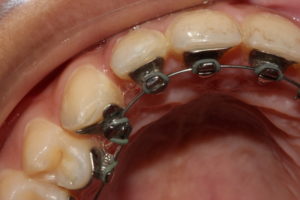
Facts About Lingual Braces
- You can achieve the same results as traditional braces, only with a hidden treatment apparatus on the tongue-side of your teeth.
- These braces have to be custom-made to the back of your teeth, because teeth size can vary from patient to patient.
- Children are not usually candidates for lingual braces. It all depends on their age and the size of their teeth. Baby teeth are small and with many patients, there is not room to fit brackets and wires on the back of the teeth. Children who have larger teeth may be candidates.
- Adults use these braces much more often than teens and children for both reasons of teeth-size and professional/social aspects.
- Patients who play wind instruments will have an easier time playing if they have lingual instead of traditional metal braces.
- A dentist must take continuing education courses and receive additional training in order to provide lingual orthodontic options to patients. This means that not all dentists give patients this option like Dr. Hardy does.
- Brackets placed on the back of the teeth are ones that others will not be able to see. You can go throughout your entire orthodontic process without others knowing that you have braces. However, others will notice your teeth becoming straighter over time.
- Because lingual braces are made of metal brackets and wires (just like traditional braces), they are able to correct bite and alignment issues. Other braces options like Invisalign, are not able to do that.
- You may want to invest in a waterpik for your teeth. Lingual braces have brackets, so food can get stuck in them, which is why you would want a waterpik to get the food out.
- Patients can care for their lingual braces the same as they would traditional metal braces.
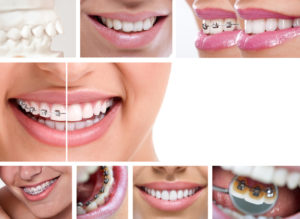
How Do They Compare?
In the past, there weren’t many options when it came to straightening your teeth. Many cultures simply tried cruel methods of pushing and forming the teeth until metal braces were created. Over several decades, metal braces were changed and adapted to how people lived. In modern times, people are ever busy and on-the-go. Aesthetics plays a huge role in how people view themselves and how others view them. This is why hidden orthodontics were created.
Lingual braces are a great way to straighten your teeth in secret. Your other options include:
- Traditional Metal Braces: These are almost the same as lingual braces, except they are made of silver metal alloys instead of gold ones. The brackets and wires go on the front of the teeth, where they are noticeable to others.
- Ceramic Braces: Similar to metal braces, this orthodontic appliance also rests on the front of your teeth. They are made of white, ceramic material, helping them to blend in more with the teeth. However, they are still somewhat noticeable.
- Invisalign Treatment: This orthodontic option involves no brackets and wires bonded to your teeth. You receive a set of transparent aligners custom-made for your teeth each week, that you wear for 20-22 hours of every day. However, although this option makes oral hygiene easier, they cannot help many bite and alignment issues. That is why patients opt for a discreet lingual option that can correct those issues.
Getting Your Lingual Braces
At Belmar Orthodontics, we know that getting braces is a big deal for teens, adults, and even children. Patients worry about their appearance often, which is why options such as Invisalign and lingual braces were invented in the first place. We are excited to be able to offer adults and teenagers an alternative to traditional metal braces with hidden lingual braces! If you want to know more about these braces or want to schedule your consultation, call Belmar Orthodontics today at (303) 225-9016!
Straightening Your Teeth Incognito-Style

Unlike traditional braces, Incognito or lingual braces are placed on the back of your teeth where they cannot be seen easily. This hidden orthodontics method is growing in popularity among those concerned about their appearance with braces. Incognito braces are completely customized to fit your mouth. If you are a working professional, a teen concerned about your appearance, a musician who plays a wind instrument, an athlete who engages in contact sports, or anyone who needs to keep the tooth-straightening behind the scenes, Incognito braces may be for you! What do Miley Cyrus, Duchess Kate Middleton, and Myleene Klass have in common? They all have benefited from the use of lingual braces! You can too!
Braces Are the Best Way to Straighten Teeth
There are many changes you can make to your appearance to help you get a leg up in your social and professional life. One of the best ways to do that is through straightening your smile. The only problem? You have to have your teeth professionally straightened so that they are done right. That’s why orthodontists exist and that’s what we specialize in—straightening your teeth.
Braces can not only improve your smile, but they can improve your confidence as well. Countless studies show that those who straighten their teeth end up having higher self esteem and confidence. Some studies—such as one done by Invisalign—showed that those with straighter teeth were perceived as more confident, successful, attractive and even trustworthy. Not bad for simply changing your smile, right?
Braces also help keep your teeth healthier. How? Crooked teeth provide plaque (and the food that makes plaque) plenty of places to get stuck. Food that becomes stuck is food that will eventually start wearing away your tooth enamel. Food particles become stuck much easier with crooked teeth than they do with straight teeth. Crooked teeth are harder to clean, are more awkward in your mouth, and they can even break easier. When you bite and chew, you exert pressure on your teeth to break up food into smaller pieces. That pressure can cause crooked teeth to crack or break, as some teeth with receive more pressure than other teeth. Straightening your teeth through braces is the best way to get your teeth healthier and prevent broken teeth.
For many adults, the thought of wearing braces for months makes them not want to straighten their teeth. That’s despite all the benefits straightening your teeth can give you. Many adults think of traditional metal braces and don’t want others to see a mouth full of metal. Millions have felt this way, so technology changed to allow adults (and even teens) the option of straightening your smile in secret.
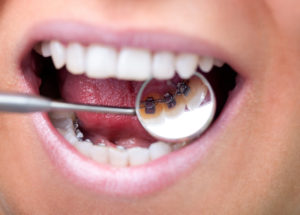
Incognito Lingual Braces
One of the best ways we straighten your teeth in secret is through Incognito lingual braces. If you’ve never heard of these, then you’re in for a treat! Traditional metal braces straighten the teeth amazingly well. That’s why these braces are referred to as “traditional” metal braces. However, some patients don’t love the thought of having a “metal mouth”. The remedy for that? Braces that lie behind the teeth instead of front and center on the teeth. We call these “incognito” braces because they are a hidden metal apparatus on the tongue-side of your teeth. It’s the perfect solution for having the strength and power of metal braces without compromising your appearance.
Millions of people wear braces each year. At least 1/4th of braces wearers are children and about the same amount are adults. Adults need options that allow them to keep their smile white and bright while also straightening it. We custom-make metal brackets for the back of each of your teeth after taking impressions of your mouth. We fit the metal to your teeth and will include brackets and an archwire just like traditional braces. Except, the entire appliance will stay hidden. Others will notice your smile improving over time, but they won’t know that it’s changing through metal braces. Straightening your teeth is easy through Incognito-style braces.
You Have Options
If you’re not completely sold on the idea of Incognito braces, you can call our office to learn more or even come in to the office to see these type of braces for yourself. However, we do have other options you can utilize for straightening your teeth. If you are looking for a similar discrete option comparable to lingual braces, you can investigate Invisalign.
Invisalign is a series of transparent aligners that transform your smile into something beautiful. You simply receive custom aligners every 1-2 weeks that slowly shape your smile into the straight pearly whites you’ve always wanted. You can remove the aligners for eating and drinking, sports activities, and for cleaning your teeth. It’s a simple, no-hassle option for straightening your teeth.
Clear, ceramic braces are also an option for those who like the idea of braces but also want them to be more hidden than metal on white teeth. Our ceramic materials mimic traditional metal braces (which we also offer), but these materials are naturally white, so they will blend in with your teeth. We can even make the archwire white as well. When it comes to straightening your teeth, you have options. However, our patients love the sturdiness of our Incognito lingual braces mixed with the hidden nature of this type of braces. We think you’ll love this option as well!
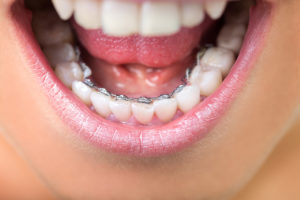
Improve Your Smile
If you could boost your confidence and self esteem, would you do it? You can through incognito braces! The best part about these amazing appliances is that no one ever has to know you are wearing braces. However, they will notice how awesome your smile looks. Others may even follow your example and straighten their own teeth. If you want to improve your smile today, don’t hesitate to take action! Call our Belmar Orthodontics office today at (303) 225-9016 to learn more about Incognito lingual braces!
What Will Wearing Braces Be Like?
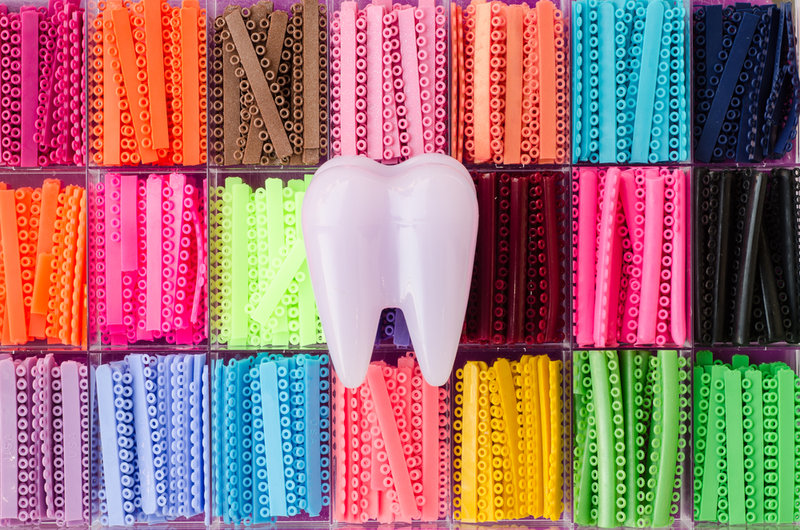
Whether you are currently wearing braces or looking into getting some, knowing what your life with braces will look (and feel) like can help you prepare for success and choose the right form of treatment for your needs and lifestyle. Belmar Orthodontics can help educate you on what to expect wearing braces and what you can do now to achieve the best outcome.
Braces: What Are They?
Braces have been around for many centuries. Researchers have found that orthodontic appliances actually date back as early as 1000 B.C. Even then people were anxious to straighten out their smiles. Braces are appliances that exert a certain amount of force on the teeth in order to align the top and bottom sets of teeth as well as the upper and lower jaw. The goal is to have a straight smile with teeth that are set in a beautiful arch around the mouth and jaws that line up with the teeth coming together evenly.
Components of Braces
Braces consist of brackets, wires and bands. On the teeth, they look like metal squares on each tooth with metal wires going through those metal squares. The squares are the brackets and they are cemented to the center of each tooth with a special bonding agent. The bracket is designed so that it can support a wire (called an archwire) that will go through it. Think of all these brackets as tiny workers who are holding up a strong wire.
There are two archwires: one that goes along the top teeth and one that goes along the bottom teeth. These archwires help shape the arch of the teeth in the mouth so that they make a perfect arch and so the upper and lower teeth line up with one another. Traditional metal braces also have rubber bands that go around each individual bracket. These are to help the gums from catching on the metal bracket hooks and also provide a patient the ability to add a pop of color to their mouth. Bands come in all different shades and can be customized to what you like.
Types of Braces
There are many options when it comes to wearing braces. Your option will largely determine how your braces look and how they feel. We provide the following options to our patients:
- Traditional Metal Braces – This is the option we explained above, and the most popular option among patients. This is also the most economical choice when it comes to price.
- Incognito Lingual Braces – This is an option similar to traditional metal braces and are popular with professionals and adults. The brackets are bonded to the back of the teeth and provide a hidden straightening apparatus to patients. Patients will adjust to these braces much the same as traditional metal braces, only they’ll feel the brackets on the tongue-side of their teeth instead of the cheek side.
- Clear Ceramic Braces – Much like metal braces, this system uses brackets to align the teeth. However, the brackets are made from ceramic and their white material blends in with the teeth. Even the wires can be made white. These will act and feel the same as metal braces, only with better blending with the teeth and greater stain-fighting power.
- Invisalign – This is a system of progressive, custom-fit aligners that gently move the teeth into their ideal position. The clear, removable design of these aligners renders this orthodontic treatment virtually invisible to others. It will feel like you are wearing a snug retainer or covering for the teeth and needs to be worn throughout the day. This treatment method allows patients to drink, eat and clean the teeth normally and with ease.
What To Expect Wearing Braces
There is some discomfort and adjustment when first wearing braces. Because the brackets are bonded to the teeth and there are archwires adjusting the position of the teeth, you may be sore for a few days. It’s best to eat soft foods the first few days as your teeth adjust to their appliances. A simple over-the-counter painkiller can help with discomfort. Although many patients feel mild discomfort when first wearing braces, some patients don’t.
It will take a few days to get used to the brackets and wires. You will be able to feel them during the day as they sit against your cheeks. However, you will get used to them in about 1-3 days to the point where you won’t even notice your braces. They will soon become a part of you and cleaning them as well as going to orthodontic appointments will become routine. As with any new thing, there is always an adjustment period. With braces, that adjustment period is short.
You’re Not Alone
When it comes to wearing braces, you’re definitely not alone. There are over 4.5 million people any given year that are wearing braces. Many of those are teenagers, but a large portion are also children and adults. In fact, at least ¼ of all braces wearers (or 25%) are adults. Each year more and more teenagers and adults are receiving braces.
In the past, there used to be many stigmas about braces, such as them being unattractive. Studies show, however, that braces have become quite the luxury and are seen as such. The New York Times, for example, did an article about braces and just how important they are to people. Many families literally go without needs and many wants to receive orthodontic care, even if money is really tight. Braces are a luxury that many children, teens, and adults alike are eager to have. Just think: when wearing braces, you are wearing a luxury item.
Your Braces
Remember, braces are something to have fun with! If you have traditional metal braces or ceramic braces, you can dress up your braces with colorful bands that make you stand out. Or you can choose an option that is discreet. Overall, no matter what option you choose, wearing braces for a time will help keep your mouth healthier and your smile straighter. A better smile leads to more confidence. Who wouldn’t want that? If you’re ready to receive a great set of braces, call our Belmar Orthodontics office today at (303) 225-9016!
How Do Adult and Child Orthodontics Differ?

Advancements in adult and child orthodontics have triggered a rise in adults seeking treatment for oral challenges they have had for years. When deciding to pursue orthodontic treatment, understanding the differences between adult and child orthodontics can help you decide what type of treatment is right for you. Everyone should want their best smile. Feeling confident about your teeth and smile is essential for healthy self-esteem and confidence. You can achieve both of those benefits with braces.
Benefits of Braces
For years, braces have helped millions of people receive a more beautiful smile. About 4 million Americans on average each year are wearing braces. You may think that braces are mostly for teenagers, but you may be surprised to know that about 25% of braces wearers are actually adults. A large portion of those 4 million are also children. Braces benefit people of all ages and it’s never too late to get your own set. Why are braces so important? Straighter teeth keep the mouth in proper alignment and help even out the pressure placed on the jaw each time you talk, bite, eat and more. When the teeth are straighter, they are easier to clean, especially to floss in between the teeth. This is why people with straighter teeth have a reduced risk for oral health problems such as tooth decay and gum disease.
Tooth Decay and Gum Disease
The biggest oral health problems are tooth decay and gum disease. These problems come from lack of good oral hygiene habits. If you skip on brushing and flossing the teeth (or not doing them enough) you may start to have problems. When food sits on the teeth, the sugars from the food you ate (or drank) mix with bacteria in the mouth. This mixture creates a sticky acidic substance called plaque. That plaque works hard to erode your tooth enamel. If it sits on the teeth long enough without being cleaned through brushing or flossing, it will seep into the center of your tooth, called the pulp. This is where that acidic plaque will start to decay your tooth. If left untreated, the problem can become severe. Tooth decay is the most wide-spread childhood disease.
Gum disease is similar to tooth decay, but it has to do with the gums. Plaque is not your friend in this case either. When it sits on the teeth for too long, it can irritate the gums. You may notice your gums begin to turn more red and they may become inflamed. Over time, if good oral hygiene habits are not established, the gums will begin to recede from the teeth. This can eventually cause the teeth to begin falling out. About 64.7 million American adults suffer from some form of gum disease. That’s not even including the number for children! Even though tooth decay and gum disease are so wide-spread, they can both be prevented by brushing and flossing several times a day and by establishing and keeping good oral hygiene habits.
Child Orthodontics
One area we specialize in is child orthodontics. A large portion of the people that wear braces are children. The American Association of Orthodontics recommends that children have their first orthodontic visit between ages 7 and 8. Having an examination early-on helps prevent the progression of orthodontic issues that may be present. In children, we can detect certain orthodontic problems—such as underbite or crossbite—that are present. These problems can be fixed with child orthodontics and other bite and alignment problems such as overbite, openbite and malocclusion. The jaw is still forming in children, so performing child orthodontics at this age can help easily correct problems that are harder to deal with as an adult. Even if your child does not show any signs or symptoms of orthodontic complications, you can still benefit from child orthodontics. Some benefits include:
- Monitoring the facial and jaw development
- Observing the progress of incoming teeth
- Guiding incoming teeth into their proper positions
- Reducing the risk of impacted teeth
- Decreasing the risk for permanent tooth extractions
- Detecting hidden dental issues
Adult Orthodontics
Adult and child orthodontics are very similar. However, it often takes longer to correct bite and alignment problems in adults than it does children or teenagers. This is because the jaw and mouth has stopped growing by adulthood. If bite or alignment problems are severe, an adult may have to look into receiving surgery to correct the problem. Adults also have a few more options when it comes to what kind of braces they would like. Adults and teenagers have the option to choose these types of braces besides traditional metal braces:
- Lingual Braces – These are also known as “Incognito” braces. They are a hidden braces apparatus on the tongue-side of your teeth. Worn on the inside, no one will even know you are wearing braces.
- Invisalign Transparent Aligners – This is a series of removable transparent aligners that are custom-made for your teeth. They can be removed for activities such as eating, drinking, sports and more. Because they are transparent, they are also a secret way for adults and teenagers to discreetly straighten their teeth.
- Clear Ceramic Braces – Made of ceramic material, these braces fit in with the color of your natural teeth. Ceramic material helps reduce the risk for demineralization and staining.
Your New Smile
Whether you are an adult or child, it’s never too late to improve your smile! For people of all ages, a straight smile boosts confidence and self esteem. For adults, that new smile of yours could help you land a job. Studies have also shown that straighter smiles make you appear more confident, successful, attractive and even more trustworthy to others. The benefits of braces are just too good to pass up! If you would like a new smile today, call our Belmar Orthodontics office at (303) 225-9016!
Incognito Lingual Braces Vs. Traditional Metal Braces
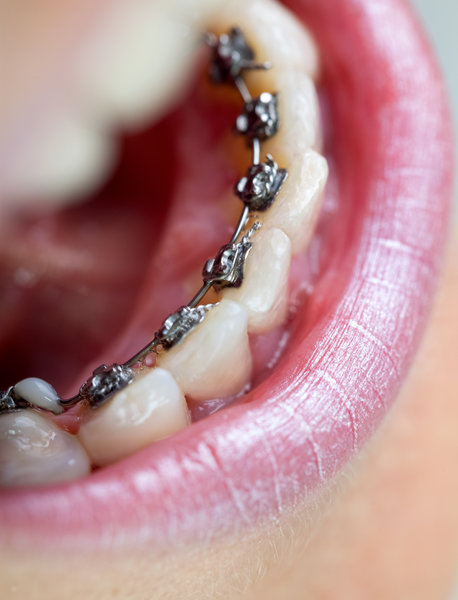
Young woman with lingual braces
There are many services we offer when it comes to straightening the teeth, including Incognito lingual braces and traditional metal braces. These two options are very similar, however, lingual braces are made slightly different than traditional metal braces because of where and how they are worn. Both will give you amazing straightening results and both are services we provide. What choice is right for you? Which is best for your budget and for your time? We can help you know the difference between Incognito lingual braces and traditional metal brackets and help you choose which option you’ll love the most. As always, with professional orthodontic care through Belmar Orthodontics, you can be sure you receive quality straightening power no matter what option you choose.
Investing In Braces
When you invest your time in braces, you are making an investment for the rest of your life. Your smile is one of the first physical features others see. Is that smile making an impression? We want all of our patients to have beautiful, healthy smiles. Why? Beautiful smiles are quite attractive to others. In studies, those with a straighter, more beautiful smile are seen as more attractive, trustworthy, confident and successful. Straighter smiles tell others that you take care of yourself.
When it comes to your health, a straighter smile can also help reduce your risk for tooth decay and gum disease. This is because the teeth are aligned and much easier to clean, especially in between the teeth. Plaque has a harder time staying stuck on the teeth and causing problems when the teeth are easier to clean. So when it comes to both aesthetic and health reasons, braces can really change your life! There are many options when it comes to choosing the right braces for you. Some of the most popular options in orthodontics are traditional metal braces and Incognito lingual braces.
Traditional Metal Braces
These are the braces you probably imagine when you think of braces. They are traditional because they’ve been around for decades and are proven to straighten your teeth effectively. Traditional metal braces are worn on the front of the teeth. In times past, the term “metal mouth” was a term some used to describe those who had these braces. However, studies have shown that braces have become a luxury in modern times.
Traditional metal braces are more popular than ever, especially among teenagers. Metal braces have also taken on a much smaller and sleeker design so you no longer have a mouth so full of metal. The best part about traditional metal braces (besides how well they work) is that they are also the least expensive option when it comes to orthodontic care. You can also dress up these braces with bright bands of color and express yourself the way you want.
Incognito Lingual Braces
Love the idea of metal braces but don’t exactly love how noticeable they are? We are excited to be able to offer our patients an alternative to traditional metal braces: hidden lingual braces. There are about 4.5 million Americans that currently wear braces. Of those, 25% are adults. The majority of the rest of braces wearers are teenagers. It is common for some adults and teenagers to avoid orthodontic treatment because they find metal braces to be unattractive or distracting. However, most people love to have straighter teeth. The solution? Incognito lingual braces!
With lingual braces, you can achieve the same results as traditional braces with a hidden treatment apparatus on the tongue-side of your teeth (by the tongue and palate). This is why they are referred to as “incognito” braces—they stay hidden (or incognito) as you straighten. We will take an impression of your teeth and make customized brackets fit perfectly to you. Lingual braces work much like traditional metal braces by slowly shifting the teeth into proper alignment. Unlike metal braces, each tooth must have its own installment of brackets and wires, as the lingual braces are shaped to each tooth back. Special training and technical expertise are needed to install these braces, and they do cost a bit more than traditional metal braces. However, you receive the trade-off of these braces being so undetectable.
Other Braces
There are more options than just traditional metal braces and Incognito lingual braces. We also offer:
- Invisalign – For those seeking an option that goes beyond Incognito braces, they can invest in Invisalign. This is a series of transparent aligners that are replaced every 1-2 weeks. They are virtually invisible and can be removed for eating, drinking, cleaning and sports.
- Ceramic Braces – Made from ceramic material, these white braces seek to have the functionality of traditional metal braces while blending into the teeth. Both the brackets and the wires can be made white so the braces are hard to see against the teeth.
Getting Your Braces
When it comes to receiving your braces, we want to give you options so that you truly enjoy your braces experience. Both traditional metal braces and lingual braces will work hard to straighten your smile. The dentists at Belmar Orthodontics have the expertise, training and experience to install both traditional metal braces or Incognito lingual braces to your smile. To start your orthodontic treatment with metal or lingual braces today, call our Belmar Orthodontics office today at (303) 225-9016!

